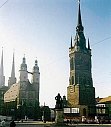Contact
International Office
phone: Tel: +49 345 55 21590
fax: Fax: +49 345 55 27427
info@international.uni-hall...
Universitätsring 19/20
06108 Halle (Saale)
postal address:
Martin-Luther-Universität Halle-Wittenberg
International Office
D-06099 Halle (Saale)
Geography
The city of Halle (Saale)

The city of Halle – conveniently situated in the middle of Germany – is the largest and most densely populated city in the state of Saxony-Anhalt, with approximately 240,000 inhabitants. In the year 2006, the city celebrated its 1,200th anniversary, which makes it one of the oldest cities in central Germany.
The rich history of Halle is reflected in its many significant places of interest and in a large variety of architectural monuments and cultural opportunities. In Halle’s city centre, one can find old buildings, elaborately restored – in styles from Art Nouveau to Baroque to Renaissance – as well as attractive new buildings with impressive architecture.
Halle, the fourth-largest city in eastern Germany, is only 38km (24mi) away from Leipzig, which is considered the centre of the region. Since 1990, the former East German chemistry metropolis has turned itself into a town of education and the sciences. In addition to Martin Luther University, one can find two other universities and numerous well-known research institutions here in Halle. Halle rests on the banks of the beautiful river Saale, which is why it has so many parks, green areas, and flood plains.
Halle is favourably situated in the heart of central Germany and can be reached by many traffic routes. The intercontinental airport of Leipzig-Halle is only 18 km (11mi) away and connected to the city by the Metropolitan Railway, or S-Bahn train. The city has two motorway connections (Autobahn = A): the A14 (Dresden - Halle - Magdeburg - Hannover) and the A9 (Munich - Halle - Berlin). From the main train station, there are many direct connections to the centre of the city. S-Bahn trains, running between the cities of Halle and Leipzig, take approximately 30 minutes.
The capital city of Berlin, as well as Frankfurt, with their large airports, are also easily reachable – both from the Halle-Leipzig airport, as well as by train.
Landscape and Climate

The city of Halle lies on the banks of the river Saale, which flows north through the town. On its banks, wide flood plains alternate with rock formations, hills and mountains. The Saale-Unstrut region (the Unstrut is a river that flows into the Saale), bordering Halle on the south, is a good example. This region is the northernmost wine-growing district in Europe and includes the towns of Naumburg and Freyburg, which are well-known for their historic, architectural monuments. In general, Saxony-Anhalt is a state with a rich history, magnificent architecture and impressive landscapes. Castles, palaces, cathedrals, and churches along the Romanesque Road, are embedded in the pure wonder of both nature and history.
Saxony-Anhalt is one of 16 states in the Federal Republic of Germany. It covers a total area of 20,445 sq km (12,676 sq. miles). By size, it is the 8th largest state in Germany, and by population, the 10th largest. It borders the states of Brandenburg, Saxony, Thuringia and Lower Saxony.
The capital of Saxony-Anhalt is Magdeburg. It is the second largest city in the state, after Halle. Nearby is the city of Dessau, where the "Bauhaus" is located. The Bauhaus provided a basis for the field of architecture and fine arts in the area. Dessau is also home to the opulent Dessau-Wörlitz garden complex. The city’s main attraction is the Wörlitzer Park which is part of the UNESCO World Heritage Site.
The landscape of Saxony-Anhalt is quite varied. From the region of Altmark in the north, the state extends across the Magdeburg region, a vast lowland, through the Harz, a low mountain range, until one comes to Thuringia. The highest mountain in the vicinity is Brocken, with an elevation of 1,141 meters (3,735 ft). Below the summit, there is a national park called Hochharz, which is an extensive wildlife sanctuary. All of these, as well as many other beautiful places of interest, are easily reachable on day excursions.
To fully appreciate the beauty of the land, one should try to adjust to the climate of the region. Saxony-Anhalt lies in a temperate climate zone. It is common for the temperature to be about 30°C (86°F) in the summer and -10°C (14°F) in the winter. (Sometimes the temperature goes even lower in the low mountain ranges.) So when packing, it is good to bring both light summer clothes and warm winter clothes.



